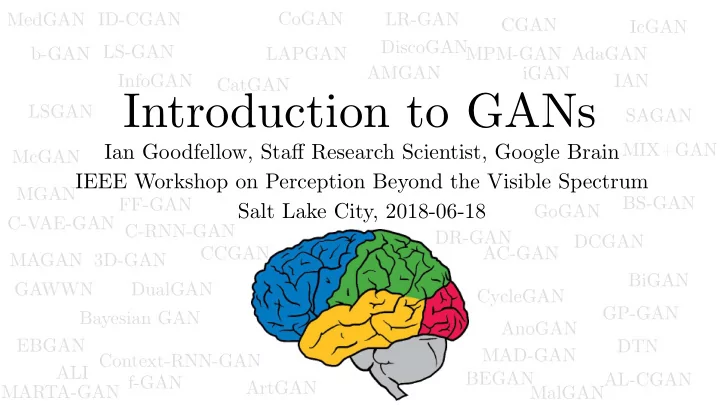

CoGAN ID-CGAN LR-GAN MedGAN CGAN IcGAN DiscoGAN LS-GAN b-GAN LAPGAN MPM-GAN AdaGAN AMGAN iGAN InfoGAN IAN CatGAN Introduction to GANs LSGAN SAGAN MIX+GAN Ian Goodfellow, Sta ff Research Scientist, Google Brain McGAN IEEE Workshop on Perception Beyond the Visible Spectrum MGAN BS-GAN FF-GAN Salt Lake City, 2018-06-18 GoGAN C-VAE-GAN C-RNN-GAN DR-GAN DCGAN CCGAN AC-GAN MAGAN 3D-GAN BiGAN GAWWN DualGAN CycleGAN GP-GAN Bayesian GAN AnoGAN EBGAN DTN MAD-GAN Context-RNN-GAN ALI BEGAN AL-CGAN f-GAN ArtGAN MARTA-GAN MalGAN
Generative Modeling: Density Estimation Training Data Density Function (Goodfellow 2018)
Generative Modeling: Sample Generation Training Data Sample Generator (CelebA) (Karras et al, 2017) (Goodfellow 2018)
Adversarial Nets Framework D tries to make D(G(z)) near 0, D (x) tries to be G tries to make near 1 D(G(z)) near 1 Di ff erentiable D function D x sampled from x sampled from data model Di ff erentiable function G Input noise z (Goodfellow et al., 2014) (Goodfellow 2018)
Self-Attention GAN State of the art FID on ImageNet: 1000 categories, 128x128 pixels Goldfish Redshank Geyser Tiger Cat Broccoli Stone Wall Indigo Bunting (Zhang et al., 2018) Saint Bernard (Goodfellow 2018)
Self-Play 1959: Arthur Samuel’s checkers agent (OpenAI, 2017) (Silver et al, 2017) (Bansal et al, 2017) (Goodfellow 2018)
What can you do with GANs? • Simulated environments and training data • Missing data • Semi-supervised learning • Multiple correct answers • Realistic generation tasks • Model-based optimization • Automated customization • Domain adaptation (Goodfellow 2018)
Autonomous Driving Data (Wang et al., 2017) (Goodfellow 2018)
GANs for simulated training data (Shrivastava et al., 2016) (Goodfellow 2018)
What can you do with GANs? • Simulated environments and training data • Missing data • Semi-supervised learning • Multiple correct answers • Realistic generation tasks • Automated customization • Domain adaptation (Goodfellow 2018)
What is in this image? (Yeh et al., 2016) (Goodfellow 2018)
Generative modeling reveals a face (Yeh et al., 2016) (Goodfellow 2018)
What can you do with GANs? • Simulated environments and training data • Missing data • Semi-supervised learning • Multiple correct answers • Realistic generation tasks • Model-based optimization • Automated customization • Domain adaptation (Goodfellow 2018)
Supervised Discriminator for Semi-Supervised Learning Real cat Real dog Fake Real Fake Learn to read with Hidden Hidden units units 100 labels rather than 60,000 Input Input (Odena 2016, Salimans et al 2016) (Goodfellow 2018)
Semi-Supervised Classification MNIST: 100 training labels -> 80 test mistakes SVHN: 1,000 training labels -> 4.3% test error CIFAR-10: 4,000 labels -> 14.4% test error (Dai et al 2017) (Goodfellow 2018)
What can you do with GANs? • Simulated environments and training data • Missing data • Semi-supervised learning • Multiple correct answers • Realistic generation tasks • Model-based optimization • Automated customization • Domain adaptation (Goodfellow 2018)
Next Video Frame Prediction Ground Truth MSE Adversarial What happens next? (Lotter et al 2016) (Goodfellow 2018)
Next Video Frame Prediction Ground Truth MSE Adversarial (Lotter et al 2016) (Goodfellow 2018)
Next Video Frame(s) Prediction Mean Squared Error Mean Absolute Error Adversarial (Mathieu et al. 2015) (Goodfellow 2018)
What can you do with GANs? • Simulated environments and training data • Missing data • Semi-supervised learning • Multiple correct answers • Realistic generation tasks • Model-based optimization • Automated customization • Domain adaptation (Goodfellow 2018)
iGAN youtube (Zhu et al., 2016) (Goodfellow 2018)
Image to Image Translation Input Ground truth Output Labels to Street Scene input output Aerial to Map input output (Isola et al., 2016) (Goodfellow 2018)
Unsupervised Image-to-Image Translation Day to night (Liu et al., 2017) (Goodfellow 2018)
CycleGAN (Zhu et al., 2017) (Goodfellow 2018)
Text-to-Image Synthesis This bird has a yellow belly and tarsus, grey back, wings, and brown throat, nape with a black face (Zhang et al., 2016) (Goodfellow 2018)
What can you do with GANs? • Simulated environments and training data • Missing data • Semi-supervised learning • Multiple correct answers • Realistic generation tasks • Model-based optimization • Automated customization • Domain adaptation (Goodfellow 2018)
Designing DNA to optimize protein binding (Killoran et al, 2017) (Goodfellow 2018)
What can you do with GANs? • Simulated environments and training data • Missing data • Semi-supervised learning • Multiple correct answers • Realistic generation tasks • Automated Customization • Domain Adaptation (Goodfellow 2018)
Personalized GANufacturing (Hwang et al 2018) (Goodfellow 2018)
What can you do with GANs? • Simulated environments and training data • Missing data • Semi-supervised learning • Multiple correct answers • Realistic generation tasks • Automated Customization • Domain Adaptation (Goodfellow 2018)
Domain Adaptation • Domain Adversarial Networks (Ganin et al, 2015) • Professor forcing (Lamb et al, 2016): Domain- Adversarial learning in RNN hidden state (Goodfellow 2018)
GANs for domain adaptation (Bousmalis et al., 2016) (Goodfellow 2018)
Tips and Tricks • Spectral normalization (Miyato et al 2017) in both discriminator and generator (Zhang et al 2018) • Di ff erent learning rate for generator and discriminator (Heusel et al 2017) • No need to run discriminator more often than generator (Zhang et al 2018) • Many di ff erent loss functions all work well (Lucic et al 2017); spend more time tuning hyperparameters than trying di ff erent losses (Goodfellow 2018)
Track updates at the GAN Zoo https://github.com/hindupuravinash/the-gan-zoo (Goodfellow 2018)
Questions (Goodfellow 2018)
Recommend
More recommend